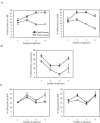Factors associated with severe granulomatous pneumonia in Mycobacterium tuberculosis-infected mice vaccinated therapeutically with hsp65 DNA
- PMID: 16041037
- PMCID: PMC1201265
- DOI: 10.1128/IAI.73.8.5189-5193.2005
Factors associated with severe granulomatous pneumonia in Mycobacterium tuberculosis-infected mice vaccinated therapeutically with hsp65 DNA
Abstract
Resistant C57BL/6 mice infected in the lungs with Mycobacterium tuberculosis and then therapeutically vaccinated with Mycobacterium leprae-derived hsp65 DNA develop severe granulomatous pneumonia and tissue damage. Analysis of cells accumulating in the lungs of these animals revealed substantial increases in T cells secreting tumor necrosis factor alpha and CD8 cells staining positive for granzyme B. Stimulation of lung cells ex vivo revealed very high levels of interleukin-10, some of which was produced by B-1 B cells. This was probably an anti-inflammatory response, since lung pathology was dramatically worsened in B-cell gene-disrupted mice.
Figures




Similar articles
-
Therapeutic efficacy of a tuberculosis DNA vaccine encoding heat shock protein 65 of Mycobacterium tuberculosis and the human interleukin 2 fusion gene.Tuberculosis (Edinb). 2009 Jan;89(1):54-61. doi: 10.1016/j.tube.2008.09.005. Epub 2008 Dec 3. Tuberculosis (Edinb). 2009. PMID: 19056317
-
Immunogenicity and protective efficacy of a DNA vaccine encoding the fusion protein of mycobacterium heat shock protein 65 (Hsp65) with human interleukin-2 against Mycobacterium tuberculosis in BALB/c mice.APMIS. 2008 Dec;116(12):1071-81. doi: 10.1111/j.1600-0463.2008.01095.x. APMIS. 2008. PMID: 19133010
-
Effect of hsp65 DNA vaccination carrying immunostimulatory DNA sequences (CpG motifs) against Mycobacterium leprae multiplication in mice.Int J Lepr Other Mycobact Dis. 2002 Sep;70(3):182-90. Int J Lepr Other Mycobact Dis. 2002. PMID: 12483966
-
The safety of post-exposure vaccination of mice infected with Mycobacterium tuberculosis.Vaccine. 2008 Nov 11;26(48):6092-8. doi: 10.1016/j.vaccine.2008.09.011. Epub 2008 Sep 20. Vaccine. 2008. PMID: 18809446
-
Immune regulatory effect of pHSP65 DNA therapy in pulmonary tuberculosis: activation of CD8+ cells, interferon-gamma recovery and reduction of lung injury.Immunology. 2004 Sep;113(1):130-8. doi: 10.1111/j.1365-2567.2004.01931.x. Immunology. 2004. PMID: 15312144 Free PMC article.
Cited by
-
B cells Can Modulate the CD8 Memory T Cell after DNA Vaccination Against Experimental Tuberculosis.Genet Vaccines Ther. 2011 Mar 14;9:5. doi: 10.1186/1479-0556-9-5. Genet Vaccines Ther. 2011. PMID: 21401938 Free PMC article.
-
Preclinical evidence for implementing a prime-boost vaccine strategy for tuberculosis.Vaccine. 2012 Apr 16;30(18):2811-23. doi: 10.1016/j.vaccine.2012.02.036. Epub 2012 Mar 3. Vaccine. 2012. PMID: 22387630 Free PMC article. Review.
-
Heat shock proteins: stimulators of innate and acquired immunity.Biomed Res Int. 2013;2013:461230. doi: 10.1155/2013/461230. Epub 2013 May 25. Biomed Res Int. 2013. PMID: 23762847 Free PMC article. Review.
-
Cell-mediated immune responses in tuberculosis.Annu Rev Immunol. 2009;27:393-422. doi: 10.1146/annurev.immunol.021908.132703. Annu Rev Immunol. 2009. PMID: 19302046 Free PMC article. Review.
-
Improve protective efficacy of a TB DNA-HSP65 vaccine by BCG priming.Genet Vaccines Ther. 2007 Aug 22;5:7. doi: 10.1186/1479-0556-5-7. Genet Vaccines Ther. 2007. PMID: 17714584 Free PMC article.
References
-
- Bean, A. G. D., D. R. Roach, H. Briscoe, M. P. France, H. Korner, J. D. Sedgwick, and W. J. Britton. 1999. Structural deficiencies in granuloma formation in TNF gene-targeted mice underlie the heightened susceptibility to aerosol Mycobacterium tuberculosis infection, which is not compensated for by lymphotoxin. J. Immunol. 162:3504-3511. - PubMed
-
- Cai, H., X. Tian, X. D. Hu, Y. H. Zhuang, and Y. X. Zhu. 2004. Combined DNA vaccines formulated in DDA enhance protective immunity against tuberculosis. DNA Cell Biol. 23:450-456. - PubMed
-
- Centers for Disease Control and Prevention. 1998. Development of new vaccines for tuberculosis. Recommendations of the Advisory Council for the Elimination of Tuberculosis (ACET). Morbid. Mortal. Wkly. Rep. 47:1-6. - PubMed
-
- Hess, J., and S. H. Kaufmann. 1999. Live antigen carriers as tools for improved anti-tuberculosis vaccines. FEMS Immunol. Med. Microbiol. 23:165-173. - PubMed
Publication types
MeSH terms
Substances
Grants and funding
LinkOut - more resources
Full Text Sources
Research Materials

